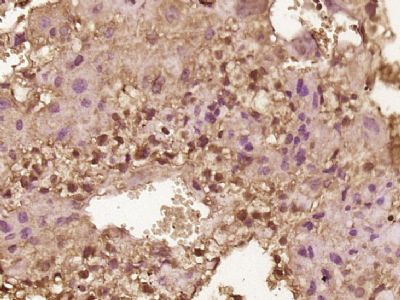MBNL3 has been shown to inhibit muscle differentiation. MBNL3 belongs to a highly conserved family of tissue-specific alternative splicing regulators. This family is known to regulate terminal muscle differentiation through alternative splicing control and several groups have suggested that the family participates in the differentiation of photoreceptors, neurons, adipocytes and blood cell types. MBNL3 is expressed in myoblasts, muscle precursor cells, and during the early stages of myogenesis, but is detected at very low levels in terminally differentiated myotubes. MBNL proteins have been shown to sequester foci of expanded-repeat transcripts and are thought to therefore play a role in the molecular pathology of a group of neuromuscular diseases including the Myotonic Dystrophies.
Function:
Mediates pre-mRNA alternative splicing regulation. Acts either as activator or repressor of splicing on specific pre-mRNA targets. Inhibits cardiac troponin-T (TNNT2) pre-mRNA exon inclusion but induces insulin receptor (IR) pre-mRNA exon inclusion in muscle. Antagonizes the alternative splicing activity pattern of CELF proteins. May play a role in myotonic dystrophy pathophysiology (DM). Could inhibit terminal muscle differentiation, acting at approximately the time of myogenin induction.
Subcellular Location:
Nucleus. Cytoplasm. Note=Greater concentration in the nucleus. In both DM1 and DM2 patients, colocalizes with nuclear foci of retained expanded-repeat transcripts.
Tissue Specificity:
Highly expressed in the placenta.
Similarity:
Belongs to the muscleblind family.
Contains 4 C3H1-type zinc fingers.
SWISS:
Q9NUK0
Gene ID:
55796
Database links:
Entrez Gene: 55796 Human
Entrez Gene: 171170 Mouse
Entrez Gene: 302492 Rat
Omim: 300413 Human
SwissProt: Q9NUK0 Human
SwissProt: Q8R003 Mouse
Unigene: 105134 Human
Unigene: 596347 Human
Unigene: 295324 Mouse
Unigene: 105030 Rat
| Picture |
Paraformaldehyde-fixed, paraffin embedded (Mouse placenta); Antigen retrieval by boiling in sodium citrate buffer (pH6.0) for 15min; Block endogenous peroxidase by 3% hydrogen peroxide for 20 minutes; Blocking buffer (normal goat serum) at 37°C for 30min; Antibody incubation with (MBNL3) Polyclonal Antibody, Unconjugated (SL5721R) at 1:500 overnight at 4°C, followed by a conjugated secondary (sp-0023) for 20 minutes and DAB staining.
|
|
|
